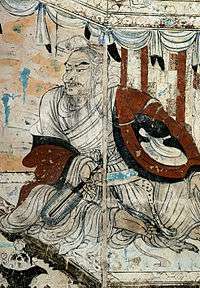Vimalakirti Sutra

| Part of a series on |
| Mahāyāna Buddhism |
|---|
 |
|
Teachings |
|
Mahāyāna schools |
|
|
The Vimalakīrti Nirdeśa Sūtra (Sanskrit: विमलकीर्तिनिर्देशसूत्र) or Vimalakīrti Sūtra is a Mahayana Buddhist sutra. Sometimes used in the title, the word nirdeśa means "instruction, advice". The sutra teaches, among other subjects, the meaning of nondualism. It contains a report of a teaching addressed to both arhats and bodhisattvas by the upāsaka (lay practitioner) Vimalakīrti, who expounds the doctrine of śūnyatā to them. This culminates with the wordless teaching of silence.
The sutra has been influential in East Asian Buddhism for its "brash humor" and flexibility. It has also been influential in Mahayana Buddhism for its inclusiveness and respect for non-monastic practitioners as well as stating the equal role of women in Buddhism.
Origins
Translator Burton Watson argues that the Vimalakīrti Nirdeśa Sūtra was likely composed in approximately 100 CE.[1] It was translated into Chinese several times, the first being produced in 188 CE, but this translation was lost over time.[1] This translation was made by the Kuṣāṇa monk Lokakṣema, who came to China from the kingdom of Gandhāra. The sūtra was translated six more times at later dates, with two especially influential translations are the Kumārajīva version (406 CE),[2] which is the most widely used, and the Xuanzang version (650 CE). Chos-nyid-tshul-khrims also translated it into Tibetan in the early 8th century.[1] Most Japanese versions are based on the Chinese Kumarajiva version. The Nagarjuna Institute of Exact Methods then made available in 2007 a Romanized Sanskrit version of what was named as Āryavimalakīrtinirdeśo Nāma Mahāyānasūtram.[3]
As Buddhavacana
The Vimalakīrti Nirdeśa Sūtra is a typical example of a Buddhavacana, which are works accepted within a tradition as being the teachings of the Buddha though the sūtra makes no claim to being the actual words of the historical Buddha, nor is it preached in a manner entirely by the Buddha.
Synopsis
The sutra features Buddha teaching the Dharma to a vast assembly of ordained saṃgha, celestial bodhisattvas, laity, and various devas and other nonhuman beings in the Amra Gardens in the city of Vaiśālī in northeastern India. Vimalakīrti, a wealthy Buddhist lay bodhisattva who is considered a paragon of Buddhist virtue, is feigning illness. When the ruler of the region and various officials and others visit him, he takes the opportunity to expound Dharma teachings.
When Śākyamuni Buddha learns of the situation he asks each of his ten major monk disciples to visit Vimalakīrti during his illness, but each in turn declines to do so, each citing a past incident during which he was reproved by Vimalakīrti for some deficiency in his understanding of the Dharma. The same is repeated with various great bodhisattvas, until Mañjuśrī, the bodhisattva of wisdom, finally agrees.
Vimalakīrti and Mañjuśrī subsequently discuss points of doctrine in Vimalakīrti's room, which miraculously accommodates the multitudes of people who have come to watch. Finally, in the Amra Gardens, Vimalakīrti and Mañjuśrī join Śākyamuni Buddha for further expositions of the Dharma and the performance of demonstrations of their supernatural powers.
The Vimalakīrti Nirdeśa Sūtra concludes with praises of the sūtra itself, and an "entrustment" scene in which Śākyamuni calls on the bodhisattva Maitreya, who is destined to be the next Buddha to appear in this world, to guard the sūtra and ensure that it is widely propagated.
Use of silence
The Vimalakīrti Nirdeśa Sūtra "offers us two dramatic and contrasting moments of silence. The first of these [is] the silence of Śāriputra", who is rendered silent during an exchange with a goddess:
Śāriputra abandons speech too quickly, after all. He has been asked a question in a particular context [...] to refuse to speak at such a point is neither an indication of wisdom, nor a means of imparting wisdom, but at best a refusal to make progress [...] Śāriputra's failed silence is but a contrastive prelude to Vimalakīrti's far more articulate silence.[4]
Vimalakīrti remains silent while discussing the subject of emptiness with an assembly of bodhisattvas. The bodhisattvas give a variety of answers on the question what non-duality is. Manjusri is the last bodhisattva to answer, and says that "by giving an explanation they have already fallen into dualism". Vimalakirti, in his turn, answers with silence. [5][lower-alpha 1]
With this emphasis on silence the Vimalakīrti Nirdeśa Sūtra served as a forerunner of the approach of the Ch'an/Zen tradition, with its avoidance of positive statements on 'ultimate reality':
The Zen tradition is avowedly the Buddhism of Vimalakirti's silence—a claim that is explicitly reinforced by the practice of silent meditation.[7]
But it does not mean that language is to be discredited completely:
Language is not, according to any Mahāyāna school, to be abandoned at the outset; it is not, whatever its limitations, a useless or a wholly misleading cognitive vehicle. To adopt an aphasia or cognitive quietism from the start would be pointless, and, as the Goddess notes, contrary to the practice of the Buddha himself, who uttered an enormous number of words during his career. But of course the episode gets its point precisely from the fact that Buddhist literature is replete with a rhetoric of silence—with episodes of especially significant silence—and indeed, as we discover a mere two chapters later in this very sutra.[4]
Influence in East Asia
The Vimalakirti Sutra has become widely popular in East Asia with the sutra becoming especially popular in the Zen school.[8] John McRae notes that in contrast to India and Tibet where the Vimalakīrti Sūtra left little discernible impact, the sūtra became one of the favorites in East Asian Buddhism.[9] However, he also states that the sūtra was not used as an object of devotion, and that no school was ever formed around it, so that it does not seem to have enjoyed the degree of popularity of some other sūtras.[9]
Richard B. Mather describes the popularity of the Vimalakīrti Sūtra in China as having multiple causes. Among those noted are its "brash" humor, its criticism of śrāvakas and Abhidharma, and the universality and flexibility of its outlook.[10] Mather states that despite its disparagement of śrāvakas, the sūtra is strongly supportive of the Saṃgha, and the text intends to sanction the pursuit of the bodhisattva path by both monastics and laity without opposition to one another.[10]
Hu Shi, an important figure in Chinese language reform in the early 20th century, wrote that the Vimalakīrti Sūtra was among Kumārajīva's three most influential translations (the other two being the Diamond Sūtra and Lotus Sūtra).[11] As a literary work, he praised this version of the sūtra as "half novel and half drama, with the greatest impact on literature and fine arts."[11] Nan Huaijin also regards this translation of the Vimalakīrti Sūtra as unique in Chinese literature, and forming "virtually its own literary realm."[12]
According to Nan Huaijin's description of the Ch'an/Zen monastic system, the abbot of the monastery customarily lived in a small room patterned after that of Vimalakīrti's room.[13] This room, as well as the abbot himself, were colloquially referred to as the fāngzhàng (Ch. 方丈), or "ten-foot square," as Vimalakīrti's room is described in the Vimalakīrti Sūtra.[13]
Translations
In Sanskrit
In 1981, the Central Institute of Higher Tibetan Studies published a Sanskrit edition of the Vimalakīrti Nirdeśa Sūtra, entitled Āryavimalakīrtinirdeśo Nāma Mahāyānasūtram (आर्यविमलकीर्तिनिर्देशो नाम महायानसूत्रम्).[14]
In Chinese
There are three ancient Chinese translations extant:
- Fóshuō Wéimójié Jīng (佛說維摩詰經) – 2 fascicles, translated by Zhi Qian in 223-228 CE (Taishō Tripiṭaka 474)
- Wéimójié Suǒshuō Jīng (維摩詰所說經) – 3 fascicles, translated by Kumārajīva in 406 CE (Taishō Tripiṭaka 475)
- Shuō Wúgòuchēng Jīng (說無垢稱經) – 6 fascicles, translated by Xuanzang in 650 CE (Taishō Tripiṭaka 476)
In addition to these, earlier translations had been done by Lokakṣema (188 CE), Dharmarakṣa (308 CE), Upaśūnya (545 CE), and Jñānagupta (591 CE). Of the three extant renditions, Kumārajīva's has traditionally been the most popular.
In Japanese
Most versions used in Japan are based on the Chinese Kumārajīva version. The Yuimagyō Gisho (維摩経義疏), or Commentary on the Vimalakīrti Sūtra, is an early work of Japanese Buddhism, and is an annotated edition of the text based on the commentary of the Liang Dynasty Chinese monk Zhizang (458-522 CE).
In Tibetan
There are two translations of the Vimalakīrti Nirdeśa Sūtra from the original Sanskrit into the Tibetan language.[15] Chos-nyid-tshul-khrims translated it into Tibetan in the ninth century.[15]
In English
- Luk, Charles (1975). Ordinary Enlightenment: A Translation of the Vimalakirti Nirdesa. Shambhala Publications. ISBN 0394730658. (From Kumārajīva's Chinese)
- Lamotte, Etienne; Boin-Webb, Sara (1976). The Teaching of Vimalakirti: Vimalakirtinirdesa. Pali Text Society. ISBN 0860130770. (An exhaustive scholarly treatment) - Translation from French
- Watson, Burton (1997). The Vimalakirti Sutra. Columbia University Press. ISBN 0231106564. (From Kumārajīva's Chinese and featuring a short introduction)
- Thurman, Robert (2000). The Holy Teaching of Vimalakirti: A Mahayana Scripture. Pennsylvania State University Press. ISBN 0271012099. (From Tibetan and featuring short introduction, extensive notes and glossary entries) [16]
- McRae, John (2004). The Sutra of Queen Śrīmālā of the Lion's Roar and the Vimalakīrti Sutra (PDF). Numata Center for Buddhist Translation and Research. ISBN 1886439311. Archived from the original (PDF) on September 12, 2014. (From Kumārajīva's Chinese and featuring short introduction, glossary, and minor notes)
See also
- Wang Wei, celebrated 8th-century Chinese poet who named himself after the Vimalakīrti.
Notes
- ↑ This dialogue is being treated in case 84 of the Hekiganroku[6]
References
- 1 2 3 Watson, Burton (1997). The Vimalakirti Sutra. Columbia University Press. pp. 1–2. ISBN 9780231106566.
- ↑ "新式譯本 Singaporean Translation". 净名经 Cheng Beng Sutra. Archived from the original on April 15, 2015. Retrieved 15 April 2015.
- ↑ "Āryavimalakīrtinirdeśo Nāma Mahāyānasūtram". Samsara. Retrieved 15 April 2015.
- 1 2 "Sounds of Silence: Ineffability and the Limits of Language in Madhyamaka and Yogācāra", by Jay L. Garfield, in Empty Words: Buddhist Philosophy and Cross-Cultural Interpretation. Oxford Univ. Press: 2002 ISBN 0-19-514672-7 pg 170-71
- ↑ Low 2000, p. 109-112.
- ↑ Low 2000, p. 110.
- ↑ "Language: Buddhist Views on Language." by Luis O. Gomez. Encyclopedia of Religion, 2nd ed. pg 5310
- ↑ Baroni, Helen Josephine (2002). The Illustrated Encyclopedia of Zen Buddhism. The Rosen Publishing Group. p. 369. ISBN 9780823922406.
- 1 2 McRae, John (2004). The Sutra of Queen Śrīmālā of the Lion's Roar and the Vimalakīrti Sutra. Numata Center for Buddhist Translation and Research. pp. 60–61. ISBN 1886439311.
- 1 2 Mather, Richard B. "Vimalakīrti and Gentry Buddhism," History of Religions, Vol. 8, No. 1 (Aug., 1968), pp. 60-73
- 1 2 Sheng Yen. Orthodox Chinese Buddhism. North Atlantic Books. 2007. p. 57
- ↑ Nan Huai-Chin. Diamond Sutra Explained. 2004. p. 6
- 1 2 Nan, Huai-Chin. Basic Buddhism: Exploring Buddhism and Zen. 1997. pp. 173-174, 211
- ↑ "Digital Sanskrit Buddhist Canon: Āryavimalakīrtinirdeśo Nāma Mahāyānasūtram".
- 1 2 Thurman, Robert (1998). The Holy Teaching of Vimalakirti. Penn State University Press. p. ix. ISBN 0271006013.
- ↑ "Vimalakirti Nirdesa Sutra". Archived from the original on 2012-02-07. Retrieved 24 October 2013.
Sources
- Low, Albert (2000), Zen and the Sutras, Boston: Turtle Publishing
Further reading
- Nattier, Jan (2000). "The Teaching of Vimalakīrti (Vimalakīrtinirdeśa): A Review of Four English Translations" (PDF). Buddhist Literature. 2: 234–258. Archived from the original (PDF) on September 10, 2011.
- Hubbard, Jamie, trans. (2012) Expository Commentary on the Vimalakīrti Sutra. Numata Center for Buddhist Translation and Research, Berkeley, ISBN 978-1-886439-44-3. (translation of the Yuimagyō-gisho)
- Silk, Jonathan (2014). Taking the Vimalakīrti seriously, Annual Report of The International Research Institute for Advanced Buddhology at Soka University 17, 157-188
- Hamlin, Edward (1988). Magical Upāya in the Vimalakīrtinirdeśa-sūtra, Journal of the International Association of Buddhist Studies 11 (1), 89-121
- Cole, Alan (2005). See chapter 6 of Text as Father: Paternal Seductions in Early Mahayana Buddhist Literature (Berkeley: University of California Press), pp. 236-325, for an in-depth account of the narrative in the Vimalakīrtinirdeśa-sūtra.